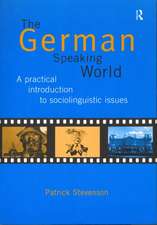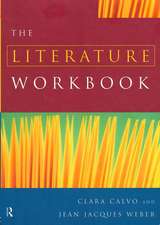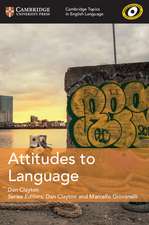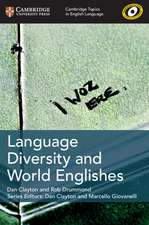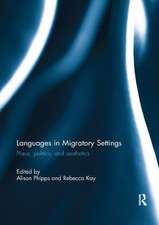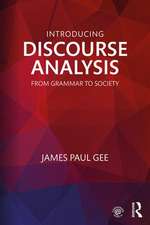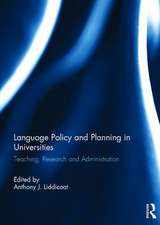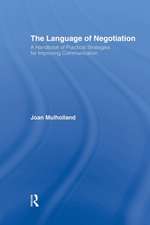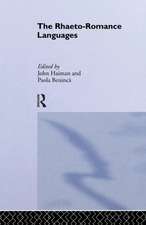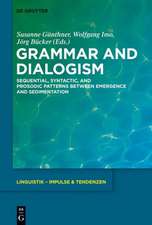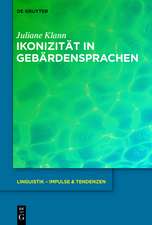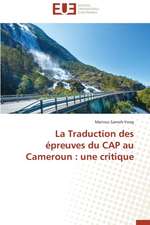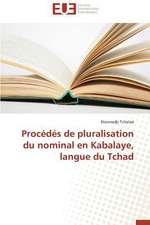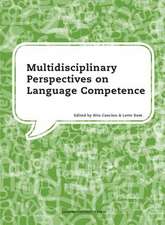Introducing Multilingualism: A Social Approach
Autor Kristine Horner, Jean Jacques Weberen Limba Engleză Hardback – 8 sep 2017
- language as a social construct
- language contact and variation
- language and identity
- the differences between individual and societal multilingualism
- translanguaging
- flexible multilingual education.
| Toate formatele și edițiile | Preț | Express |
|---|---|---|
| Paperback (1) | 289.31 lei 22-36 zile | +24.46 lei 5-11 zile |
| Taylor & Francis – 29 aug 2017 | 289.31 lei 22-36 zile | +24.46 lei 5-11 zile |
| Hardback (1) | 1005.01 lei 43-57 zile | |
| Taylor & Francis – 8 sep 2017 | 1005.01 lei 43-57 zile |
Preț: 1005.01 lei
Preț vechi: 1225.61 lei
-18% Nou
Puncte Express: 1508
Preț estimativ în valută:
192.37€ • 209.03$ • 161.69£
192.37€ • 209.03$ • 161.69£
Carte tipărită la comandă
Livrare economică 21 aprilie-05 mai
Preluare comenzi: 021 569.72.76
Specificații
ISBN-13: 9781138244481
ISBN-10: 1138244481
Pagini: 324
Ilustrații: 10 Line drawings, black and white
Dimensiuni: 156 x 234 x 19 mm
Greutate: 0.59 kg
Ediția:Nouă
Editura: Taylor & Francis
Colecția Routledge
Locul publicării:Oxford, United Kingdom
ISBN-10: 1138244481
Pagini: 324
Ilustrații: 10 Line drawings, black and white
Dimensiuni: 156 x 234 x 19 mm
Greutate: 0.59 kg
Ediția:Nouă
Editura: Taylor & Francis
Colecția Routledge
Locul publicării:Oxford, United Kingdom
Public țintă
Postgraduate and UndergraduateCuprins
Acknowledgements
Part I: Theoretical and methodological considerations
Chapter 1: Introduction
A social approach to multilingualism
A note on terminology
Coping with change
How the book is structured
Chapter 2: Theoretical and methodological framework
The construction of meaning
Dominant vs. critical readings
Towards an ethnographically based discourse analysis
The study of language ideologies
Conclusion
Part II: Multilingualism within and across languages
Chapter 3: What is a language?
Discourse models of language
What is standard English?
‘English’ is a mere label
The fuzzy boundaries of named languages
Consequences for teaching
Consequences for research
Conclusion
Chapter 4: Language variation and the spread of global languages
African-American English
Caribbean ‘nation language’
Singlish
The global spread of English
Two French youth languages
Conclusion
Chapter 5: Revitalization of endangered languages
Australian Aboriginal languages: a history of oppression
Māori in New Zealand: a revitalization success story
Sámi and Kven in Norway: differential positionings on the success-failure continuum
Hebrew in Israel: the costs of revitalization
Breton in France: how (not) to standardize
Corsican and the polynomic paradigm
Conclusion
Part III: Societal and individual multilingualism
Chapter 6: Societal multilingualism
Ukraine
Switzerland
Singapore
Hong Kong and China
South Africa
Nigeria
Conclusion
Chapter 7: Language and identities
Categorization
Gee’s four ways to view identity
Identity: a peach or an onion?
Ethnic and national identity
Code-switching and identity
Translanguaging identities
Conclusion
Chapter 8: The interplay between individual and societal multilingualism
The Canadian policy of bilingualism and multiculturalism
Some consequences for First Nations people
Quebec francophone nationalism
Individual bilingualism through institutional monolingualism
Exclusion through French, inclusion through English
Shifting ideologies
Conclusion: the commodification of language
Part IV: Multilingualism in education and other institutional sites
Chapter 9: Flexible vs. fixed multilingualism
US vs. EU language-in-education policy
Case Study 1: Luxembourg
Case Study 2: Catalonia and the Basque Country
Discussion and conclusion: towards flexible multilingualism
Chapter 10: Mother tongue education or literacy bridges?
The case for mother tongue education: African-American English
The case against mother tongue education (in four steps): South Africa
The problems with mother tongue education
Towards literacy bridges
Conclusion: a possible solution for South Africa
Chapter 11: Heritage language education
From mother tongue education to heritage language education
Language and heritage in the United States
Language and heritage in England
The dominance of the standard language and purist ideologies
Discussion and conclusion: implications for the EU policy of multilingualism
12 Multilingualism in other institutional sites
Multilingualism in the workplace
Multilingualism in legal settings and asylum procedures
Language use in multilingual families
Part V: Critical analysis of discourses
Chapter 13: Institutional discourses on language and migration
The discourse of integration
Language testing and citizenship
Conclusion: unpacking the discourses of integration and language testing
Chapter 14: Media representations of multilingualism
Past vs. present perceptions of multilingualism in the media
Firwat ass alles schief gaangen?: responses to Luxembourg’s PISA results
Constructing the UK as an English-only space
The English Only movement in the US
Conclusion: a historical perspective on the one nation–one language ideology
Chapter 15: Multilingualism in the new media
New media sociolinguistics
Digital ethnography
Language contact phenomena in digital language
The limited multilingualism of the Internet
Language policing in the social media
Conclusion
Chapter 16: Linguistic landscape
Limitations of (some) linguistic landscape analyses
Language contact phenomena on multilingual signs
Some basic distinctions
Contextualizing and historicizing linguistic landscapes
Exploring the context of reception
Discussion and conclusion: discourses in place
Part VI: Further directions in the study of multilingualism
Chapter 17: Conclusion
Further directions in the study of multilingualism
Moving into a multilingual future
Normalizing multilingualism
Notes on the activities
Notes on the quizzes
Author index
Subject index
Part I: Theoretical and methodological considerations
Chapter 1: Introduction
A social approach to multilingualism
A note on terminology
Coping with change
How the book is structured
Chapter 2: Theoretical and methodological framework
The construction of meaning
Dominant vs. critical readings
Towards an ethnographically based discourse analysis
The study of language ideologies
Conclusion
Part II: Multilingualism within and across languages
Chapter 3: What is a language?
Discourse models of language
What is standard English?
‘English’ is a mere label
The fuzzy boundaries of named languages
Consequences for teaching
Consequences for research
Conclusion
Chapter 4: Language variation and the spread of global languages
African-American English
Caribbean ‘nation language’
Singlish
The global spread of English
Two French youth languages
Conclusion
Chapter 5: Revitalization of endangered languages
Australian Aboriginal languages: a history of oppression
Māori in New Zealand: a revitalization success story
Sámi and Kven in Norway: differential positionings on the success-failure continuum
Hebrew in Israel: the costs of revitalization
Breton in France: how (not) to standardize
Corsican and the polynomic paradigm
Conclusion
Part III: Societal and individual multilingualism
Chapter 6: Societal multilingualism
Ukraine
Switzerland
Singapore
Hong Kong and China
South Africa
Nigeria
Conclusion
Chapter 7: Language and identities
Categorization
Gee’s four ways to view identity
Identity: a peach or an onion?
Ethnic and national identity
Code-switching and identity
Translanguaging identities
Conclusion
Chapter 8: The interplay between individual and societal multilingualism
The Canadian policy of bilingualism and multiculturalism
Some consequences for First Nations people
Quebec francophone nationalism
Individual bilingualism through institutional monolingualism
Exclusion through French, inclusion through English
Shifting ideologies
Conclusion: the commodification of language
Part IV: Multilingualism in education and other institutional sites
Chapter 9: Flexible vs. fixed multilingualism
US vs. EU language-in-education policy
Case Study 1: Luxembourg
Case Study 2: Catalonia and the Basque Country
Discussion and conclusion: towards flexible multilingualism
Chapter 10: Mother tongue education or literacy bridges?
The case for mother tongue education: African-American English
The case against mother tongue education (in four steps): South Africa
The problems with mother tongue education
Towards literacy bridges
Conclusion: a possible solution for South Africa
Chapter 11: Heritage language education
From mother tongue education to heritage language education
Language and heritage in the United States
Language and heritage in England
The dominance of the standard language and purist ideologies
Discussion and conclusion: implications for the EU policy of multilingualism
12 Multilingualism in other institutional sites
Multilingualism in the workplace
Multilingualism in legal settings and asylum procedures
Language use in multilingual families
Part V: Critical analysis of discourses
Chapter 13: Institutional discourses on language and migration
The discourse of integration
Language testing and citizenship
Conclusion: unpacking the discourses of integration and language testing
Chapter 14: Media representations of multilingualism
Past vs. present perceptions of multilingualism in the media
Firwat ass alles schief gaangen?: responses to Luxembourg’s PISA results
Constructing the UK as an English-only space
The English Only movement in the US
Conclusion: a historical perspective on the one nation–one language ideology
Chapter 15: Multilingualism in the new media
New media sociolinguistics
Digital ethnography
Language contact phenomena in digital language
The limited multilingualism of the Internet
Language policing in the social media
Conclusion
Chapter 16: Linguistic landscape
Limitations of (some) linguistic landscape analyses
Language contact phenomena on multilingual signs
Some basic distinctions
Contextualizing and historicizing linguistic landscapes
Exploring the context of reception
Discussion and conclusion: discourses in place
Part VI: Further directions in the study of multilingualism
Chapter 17: Conclusion
Further directions in the study of multilingualism
Moving into a multilingual future
Normalizing multilingualism
Notes on the activities
Notes on the quizzes
Author index
Subject index
Notă biografică
Kristine Horner is Reader in Luxembourg Studies and Multilingualism at the University of Sheffield, where she is also Director of the Centre for Luxembourg Studies. Her upcoming publications include a new edition of The German-speaking World (2018).
Jean-Jacques Weber is Professor of English and Education at the University of Luxembourg. His most recent book publications are Language Racism (2015) and Flexible Multilingual Education: Putting Children’s Needs First (2014).
Jean-Jacques Weber is Professor of English and Education at the University of Luxembourg. His most recent book publications are Language Racism (2015) and Flexible Multilingual Education: Putting Children’s Needs First (2014).
Descriere
Introducing Multilingualism is a comprehensive and user-friendly introduction to the dynamic field of multilingualism. Adopting a compelling social and critical approach, the authors expertly guide readers through the established theories, leading them to question dominant discourses on subjects such as integration, heritage and language testing. This second edition has been fully revised and updated, featuring new chapters on multilingualism in new media, the workplace and the family. This is essential reading for undergraduate students and postgraduate students studying multilingualism.

